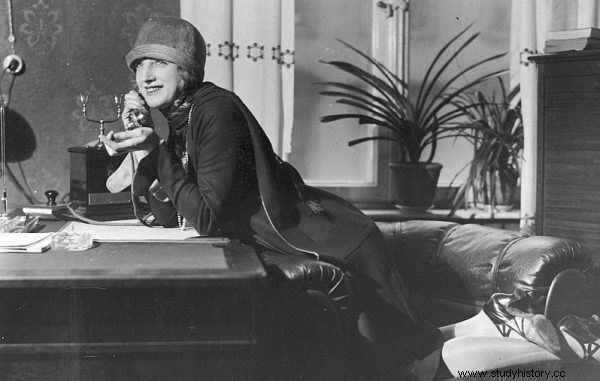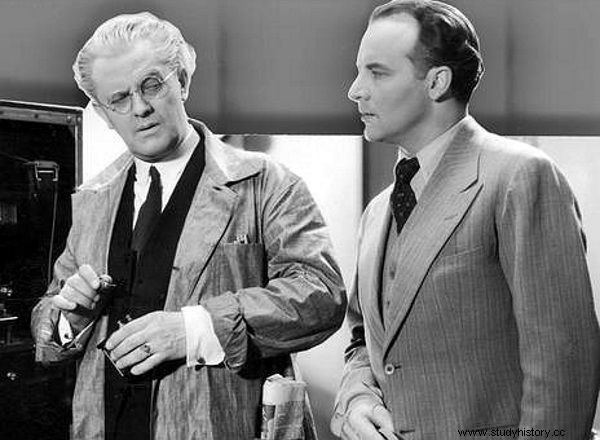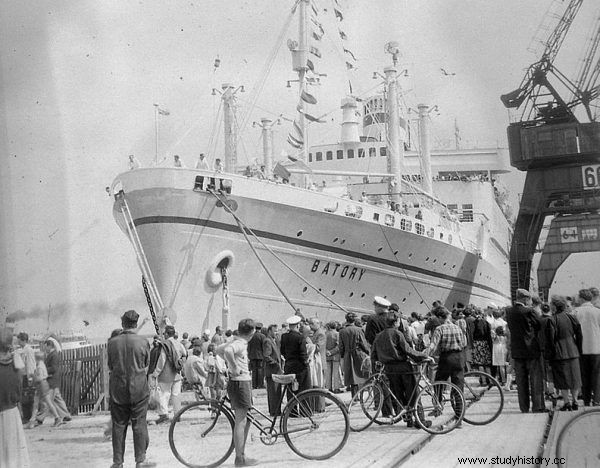An elderly lover, a Nazi informant, an officer in the Red Army - the list of Ordonka's lovers was long. The actress "serially" cheated on her husband, count Tyszkiewicz, however, turned a blind eye to his wife's antics. Was he so naive, blindly in love, or maybe ... embarrassed because he had married her despite his family's opposition?
At first he worshiped her from hiding. In the end, however, he decided to take the first step - he wrote the text "Streets in Barcelona" to the melody of an Argentine tango and took it to the director of the cabaret Qui Pro Quo. He gave it to Ordonce, who wanted to meet the author of a lovely song.
“He turned out to be a handsome, impeccably dressed, elegant, intelligent and eloquent man, and in addition he was clearly infatuated with her. Ordonka accepted his invitation to dinner "- Iwona Kienzler describes their meeting in the book" Arystokracja. Romances and love in the 20th century ”. It was the beginning of a great love. At least from Michał Tyszkiewicz. As it turned out soon, the famous actress had a slightly different approach to this relationship ...
Outrageous misalliance
At first, however, everything ran smoothly. In love, Tyszkiewicz asked the chosen one of his heart for a hand, and she agreed. It seemed that nothing could stand in the way of their shared happiness. Well, maybe except for the count's relatives, who watched the development of events with horror. As Anna Mieszkowska recalls in the latest Ordonówna biography:
Nobody in the family could understand that Michał would commit such a misalliance ! Flirting, an affair with a "cabaret woman" probably still belonged to the canon of behavior of handsome, educated and, above all, well-born young men interested in music and theater. But the wedding ?! It was too much!

Ordonka was a coquette with a great temperament. She didn't really hide from her husband about her affairs.
Tyszkiewicz's family could not accept his choice for a long time. Not only was the fiancée practiced in an extremely underestimated profession (ladies earning a living on the stage were even compared to employees of brothels), but she also came from a simple railway family. Meanwhile, she was to marry an heir to a huge fortune of borderland magnates. The area of the count's Orniany estate was as much as 15,000 hectares!
Ultimately, however, Tyszkiewicz got his way. He married Ordonka on March 26, 1931 in the church of St. Cross in Warsaw. From that moment on, a new stage in his life began. However, contrary to expectations, the marriage did not bring him happiness, but only ... bitterness and numerous disappointments .
"The count literally tried to favor his spouse to heaven, but Ordonka was probably not entirely happy with him, since she cheated on him, and practically throughout the entire period of their cohabitation" - Iwona Kienzler emphasizes in the book "Aristocracy. Romances and loves in the 20th century ”.
Eros with the belly
She was drawn to men of higher standing from the world of theater and revue. Even before the wedding, she "had" several turbulent relationships with older men - incl. with actor Janusz Sarnecki. Apparently, after parting ways, she tried to commit suicide. Her next love was the Hungarian announcer, Fryderyk Járosy. The couple lived for months in the George Hotel in Warsaw . Legalizing the relationship was out of the question as Járosy was already married and had two children.
With such an emotional baggage, Hanka Ordonówna (actually Maria Anna Pietruszyńska) entered into a relationship with an emotional and stable count. It's hard to say what she expected from him. With a high degree of probability, however, it can be assumed that the spouse turned out to be just ... too boring for her.
They lived in the Tyszkiewicz family estate in Lithuania, but Ordonka was drawn to the stage. Cooperation was offered to her by Juliusz Osterwa - one of the greatest Polish actors of the time. She was to play alongside him in Krakow, in Shakespeare's play "Twelfth Night". Hanka agreed without hesitation, even though it meant a six-month break from her husband . "Teddy bear" - as she affectionately called him - let his wife go to Krakow without a word.
Perhaps he had not expected that Osterwa, plump and eighteen years older than Maria, would be a competitor to him. If so, he has made a serious mistake. Osterwa was able to influence the fair sex:"(...) as a master in the art of seduction, he looks at ladies deeply in the eyes of the actors , he makes compliments with a vibrating voice and kind of instinctively takes his hand - recalled Tadeusz Wittlin.
The relationship between Osterwa and Ordonówna quickly became the subject of rumors - so it is almost impossible that neither of them reached Tyszkiewicz's ears. It is possible, however, that the count decided to sweep the matter under the carpet. In the end, his wife had fun with the aging star, and when she too got bored, she abandoned him unscrupulously. The poor man broke down and was treated psychiatrically. Later, the lover managed to persuade Hanka to perform in the play "Eros and Psyche", where he himself played the role of the Greek god of love. It didn't work for Ordonka anymore.
Love on Batory
Which does not mean that she meekly returned to her husband. Her new chosen one was Igo Sym - a later Nazi spy and collaborator. The son of a Pole and an Austrian, he seduced with his beauty and impeccable manners. This is what he built his acting career on. He once starred with Hanka in the movie "Spy in a Mask". Then they performed together in a circus revue. The enchanted Boy-Żeleński wrote about them:" Ordonka and Sym in one form or another make one of the nicest couples in love ”.
And this relationship did not last long. In 1937, the actress set off to conquer the USA. During her voyage across the ocean on the transatlantic Batory, the first officer - Jan Strzembosz, caught her eye. And it's hardly surprising. A sailor could be liked by women. He had a cheeky fringe, a strong build, and a shiny look. After disembarking in New York, he took Hanka to dance and dinner.

Igo Sym (right) starred alongside Ordonka in the movie "Spy in a Mask" (frame above).
“They met again a month later, having intoxicating days and even hotter nights aboard the Batory. Meanwhile, a longing spouse was waiting for the artist in the port of Gdynia "- describes their romance Iwona Kienzler. Ordonek burst into tears as she said goodbye. She had never imagined that life would soon bring her more serious reasons to cry.
September 1939 came, and an old lover entered the life of the countess, whom she had probably already forgotten. Igo Sym, however, remembered. Even worse, after the outbreak of the war, it turned out that he preferred the swastika to the white and red flag. As a "partial" German and collaborator, he was supported by the invaders. Well-established in Nazi circles, he led, inter alia, "nur für Deutsche" cinema.
He began to persuade his fellow actors to play in Nazi propaganda productions. The offer also went to Ordonka, but she refused. Then the Gestapo visited her. Today, historians believe that Sym. Even if it wasn't, he didn't lift a finger to help his former mistress. But her faithful husband did not disappoint.
Naive or hopelessly in love?
“The Count moved heaven and earth to get his beloved out of prison. To this end, he took advantage of the connections between his cousin and the king of Italy, Viktor Emanuel, who personally intervened to free the artist with Hitler himself, ”recalls Iwona Kienzler in the book“ Aristokracja. Romances and loves in the 20th century ”.
For over a year, the couple led a relatively normal life in Vilnius, mainly due to the fact that Tyszkiewicz got them Lithuanian passports. But when in 1941 the USSR occupied these territories, the count was imprisoned in Moscow's Lubyanka. He was followed by Ordonka, who ... probably got into a short affair with an NKVD officer - a certain Mikułka. It is known that he spent the night with her - allegedly promising her help in freeing her husband.

One of her loves - the sailor Jan Strzembosz - Ordonka met on board Batory.
The promises turned out to be empty. The Soviets put more and more pressure on the talented Polish woman to become a Soviet citizen. After she refused, they sent her to Uzbekistan. In a penal colony, she was sent to hard physical labor. Ordonówna, suffering from relapsing tuberculosis, miraculously survived this period.
Tyszkiewicz came to her aid again , released from prison under the Sikorski-Majski pact. The spouses met in Ashgabat in Uzbekistan, where the count ran a social welfare facility for Polish refugees. His wife at that time became involved in helping Polish orphans in the east. And in this matter, she could count on her husband's support. He organized a transport for his beloved and 200 children under her care from Soviet Uzbekistan to Bombay, India.
Return of the sailor
He could not know that he was pushing Hanka into the arms of her lover. Here a Polish ship moored in Bombay. Ordonka invited sailors to the orphanage she was running. What emotions must have torn her when the captain of the unit - Jan Strzembosz entered the facility! Soon the romance blossomed again and continued for the next few weeks .
At that time, Tyszkiewicz was absorbed in his work in a diplomatic mission in Iran. Soon after, he brought his impoverished wife there. It was made of leather to provide entertainment and attractions - they visited, among others Shah's palace, attended banquets and luxurious venues. The count also showered Hanka with gifts and bought her expensive jewelry. All for nothing. She couldn't love him.

Not paying attention to her husband's efforts, she continued her relationship with Strzembosz from a distance. They corresponded with each other for 8 years. Tyszkiewicz must have known about it, because he was passing the letters to Ordonka . Strzembosz sent them to the address of the Polish Legation in Tehran. Even so, he never looked at them, and he never made his beloved row over it.
After the war, the Tyszkiewicz family settled in Beirut. One of the last love episodes in the artist's biography was an affair she got into with one of the doctors during her stay in a hospital in Haifa. As Iwona Kienzler recalls in her book:
For her it was nothing serious, she probably just wanted to drown out her longing for Strzembosz, but the unfortunate man fell in love with the patient seriously, although he had a wife and four children . Unable to deal with this complicated situation, he took his own life .
In 1950, the actress died prematurely - she was only 48 years old. Her husband, betrayed many times, outlived her by 24 years. After some time, he found a new partner with whom he got married. Until the end of his days, however, he did not forget about his first wife. He organized an exhibition of her paintings in London and dedicated one of Radio Free Europe's broadcasts to her. He was living proof that true love forgives everything - even a lie, betrayal and sin…
Bibliography:
- Adrjański Zbigniew, Stage kaleidoscope. Lexicon of Polish entertainment 1944–1989:artists, creators, personalities , Bellona 2002.
- Kienzler Iwona, Aristocracy. Romances and love in the 20th century , Lira 2018.
- Machalski Franciszek, From Persian land to Poland , Academic Bookstore 2016.
- Mieszkowska Anna, Hanka Ordonówna. Love will forgive her everything , Prószyński i S-ka 2019.
- Sempoliński Ludwik, Great artists of small scenes, Reader 1977.
- Słonimski Antoni, Alphabet of memories , State Publishing Institute 1989.
- Szczublewski Józef, Osterwa's Life , State Publishing Institute 1973.
- Tadeusz Wittlin, The Singer of Warsaw. Hanka Ordonówna and her entourage , LTW 1990.
